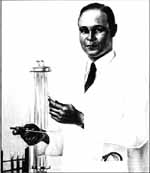 1 October 1940 African-American physician Dr. Charles Richard Drew, who pioneered a system for storing blood plasma thereby originating the "blood bank," served as director of the First Plasma Division Blood Transfusion Association. This British organization supplied plasma for British troops during WWII. In 1941, Drew was appointed to be the first director of the American Red Cross Blood Bank, which supplied blood to U.S. forces. He resigned from this position, however, to protest the organization's November 1941 decision to exclude black blood donors. Dr. Drew's research was responsible for saving countless lives during WWII.
1 October 1940 African-American physician Dr. Charles Richard Drew, who pioneered a system for storing blood plasma thereby originating the "blood bank," served as director of the First Plasma Division Blood Transfusion Association. This British organization supplied plasma for British troops during WWII. In 1941, Drew was appointed to be the first director of the American Red Cross Blood Bank, which supplied blood to U.S. forces. He resigned from this position, however, to protest the organization's November 1941 decision to exclude black blood donors. Dr. Drew's research was responsible for saving countless lives during WWII.
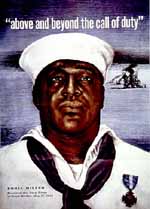 7 December 1941 Japan attacked the U.S. naval base at Pearl Harbor. During the assault, U.S. Navy messman Doris (Dorie) Miller helped move his mortally wounded commander to shelter, then manned a machine gun on the USS Arizona and shot down about six of the Japanese aircraft. This was a particularly notable accomplishment, since combat positions were not open to black sailors and Miller had no formal training on this kind of weapon. After a lengthy press campaign, the Navy awarded Miller the Navy Cross, which Admiral Chester W. Nimitz presented in a ceremony held on 27 May 1942. Miller was one of the more than 600 crewmen killed in November 1943 when the Japanese torpedoed the USS Liscombe Bay. In recognition of Miller's valor, the Navy commissioned the destroyer escort USS Miller on 30 June 1973.
7 December 1941 Japan attacked the U.S. naval base at Pearl Harbor. During the assault, U.S. Navy messman Doris (Dorie) Miller helped move his mortally wounded commander to shelter, then manned a machine gun on the USS Arizona and shot down about six of the Japanese aircraft. This was a particularly notable accomplishment, since combat positions were not open to black sailors and Miller had no formal training on this kind of weapon. After a lengthy press campaign, the Navy awarded Miller the Navy Cross, which Admiral Chester W. Nimitz presented in a ceremony held on 27 May 1942. Miller was one of the more than 600 crewmen killed in November 1943 when the Japanese torpedoed the USS Liscombe Bay. In recognition of Miller's valor, the Navy commissioned the destroyer escort USS Miller on 30 June 1973.
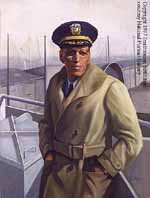 20 October 1942 At least four blacks captained Merchant Marine "liberty ships" during WW2. The best known was Hugh Mulzac, who was the first black captain of an American Merchant Marine ship. Although he was the first black sailor to earn a shipmaster's license (1920), this was his first position of command because racism had denied him earlier opportunities to serve as captain. While in charge of the mixed-crew liberty ship SS Booker T. Washington, Mulzac and his men saw action several times while on convoy duty in the Atlantic. The ship made 22 round-trip voyages in the 5 years (1942-47) it was in operation, and carried 18,000 troops to the European and Pacific theaters. Unlike the armed forces, the Merchant Marine was integrated from the start of WWII. Of the government-built "liberty ships," 14 were christened for outstanding African Americans, 4 for deceased black sailors, and 4 for Negro colleges. The Booker T. Washington was turned back over to the Maritime Commission in 1947.
20 October 1942 At least four blacks captained Merchant Marine "liberty ships" during WW2. The best known was Hugh Mulzac, who was the first black captain of an American Merchant Marine ship. Although he was the first black sailor to earn a shipmaster's license (1920), this was his first position of command because racism had denied him earlier opportunities to serve as captain. While in charge of the mixed-crew liberty ship SS Booker T. Washington, Mulzac and his men saw action several times while on convoy duty in the Atlantic. The ship made 22 round-trip voyages in the 5 years (1942-47) it was in operation, and carried 18,000 troops to the European and Pacific theaters. Unlike the armed forces, the Merchant Marine was integrated from the start of WWII. Of the government-built "liberty ships," 14 were christened for outstanding African Americans, 4 for deceased black sailors, and 4 for Negro colleges. The Booker T. Washington was turned back over to the Maritime Commission in 1947.
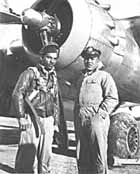 7 March 1942 Captain Benjamin O. Davis, Jr., and four second lieutenants became the first five graduates of the Tuskegee Flying School. They also were the first members of the 99th Pursuit Squadron, which had been activated with a planned total of 33 pilots and 27 planes. Later known as the 99th Fighter Squadron, the unit grew to 43 men by the end of 1942. These black pilots flew over 500 missions and 3700 sorties during 1 year of combat in Italy before the squadron was combined with the 332nd Fighter Group.
7 March 1942 Captain Benjamin O. Davis, Jr., and four second lieutenants became the first five graduates of the Tuskegee Flying School. They also were the first members of the 99th Pursuit Squadron, which had been activated with a planned total of 33 pilots and 27 planes. Later known as the 99th Fighter Squadron, the unit grew to 43 men by the end of 1942. These black pilots flew over 500 missions and 3700 sorties during 1 year of combat in Italy before the squadron was combined with the 332nd Fighter Group.
24 April 1943 The 99th Pursuit Squadron arrived in French Morocco for training under experienced combat pilots, but they received little help from the white aviators. The squadron had also been sent overseas without much of the required navigational training given to white pilots, because installations without segregated facilities refused to allow black pilots to land. Despite such obstacles, this first group of "Tuskegee Airmen" trained themselves, and were prepared to fly their first combat mission in the Mediterranean by 2 June 1943.
17 March 1944 The U.S. Army Air Corps' all-black 332nd Fighter Group (which included the 100th, 301st and 302nd Fighter Squadrons) first saw combat. Activated at Tuskegee Air Field on 26 May 1942, Colonel Benjamin O. Davis, Jr., assumed command of the group at Selfridge Field, Michigan, in October 1943. The 99th Fighter Squadron joined the 332nd in July 1944. The famed "Tuskegee Airmen" flew 1,578 missions and 15,533 sorties, during which they destroyed 261 enemy aircraft and damaged another 148 planes. The Germans called the group the Black Birdmen (or Schwartze Vogelmann), while many white U.S. bomber crews referred to their escorts as the "Redtail Angels." The group lost 66 men who were killed in action between 1941 and 1945. The 332nd received a Presidential Unit Citation on 24 March 1945 for "outstanding courage, aggressiveness, and combat technique" while escorting heavy bombers over Germany.
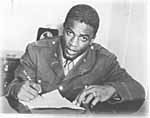 6 July 1944 Army Lieutenant John Roosevelt Robinson, one of the 761st "Black Panther" Tank Battalion's few black officers, refused orders to sit in the back of a military bus at Fort Hood, Texas. He was subsequently court martialed, but acquitted because the order was a violation of War Department policy prohibiting racial discrimination in recreational and transportation facilities on all U.S. Army posts. After the war, Jackie Robinson went on to break the "color line" in baseball by being the first black to play for the Brooklyn Dodgers. The 761st "Black Panther" Tank Battalion became the first African-American armored unit to enter combat 8 Nov 1944 during an assault on the French towns of Moyenvic and Vic-sur-Seille. The 761st Tank Battalion participated in the American counteroffensive during and after the Battle of the Bulge 31 Dec 1944-2 Feb 1945. The "Black Panthers" were able to split the German lines at three points, thereby preventing the resupply of the enemy forces surrounding American troops at Bastogne. Beginning on 20 Mar 1945 until 23 Mar, the "Black Panthers" helped to breech the Siegfried Line (or West Wall). This was a code name originating in WWI given to a series of concrete pillboxes, bunkers, and observation posts stretching along Germany's western border from Aachen south and southeast to the Rhine River, then to the Swiss border. The 761st Tank Battalion destroyed many of the defensive positions, captured seven German towns, and took control of a lot of German war materiel. The unit was also one of the first U.S. elements to join up with eastward-moving Soviet forces on 5 May 1945 at Steyr, Austria. For its impressive accomplishments in WWII, the 761st belatedly received a Presidential Unit Citation in 1978. The all-black 761st Tank Battalion was nominated in 1945 for a Presidential Unit Citation for its exceptional contributions in the European theater. Nominated six times between 1945 and 1976, the unit's award was not presented until 1978. The 761st was a notable exception to the usual U.S. Army practice in WWII of excluding most African Americans from combat duty.
6 July 1944 Army Lieutenant John Roosevelt Robinson, one of the 761st "Black Panther" Tank Battalion's few black officers, refused orders to sit in the back of a military bus at Fort Hood, Texas. He was subsequently court martialed, but acquitted because the order was a violation of War Department policy prohibiting racial discrimination in recreational and transportation facilities on all U.S. Army posts. After the war, Jackie Robinson went on to break the "color line" in baseball by being the first black to play for the Brooklyn Dodgers. The 761st "Black Panther" Tank Battalion became the first African-American armored unit to enter combat 8 Nov 1944 during an assault on the French towns of Moyenvic and Vic-sur-Seille. The 761st Tank Battalion participated in the American counteroffensive during and after the Battle of the Bulge 31 Dec 1944-2 Feb 1945. The "Black Panthers" were able to split the German lines at three points, thereby preventing the resupply of the enemy forces surrounding American troops at Bastogne. Beginning on 20 Mar 1945 until 23 Mar, the "Black Panthers" helped to breech the Siegfried Line (or West Wall). This was a code name originating in WWI given to a series of concrete pillboxes, bunkers, and observation posts stretching along Germany's western border from Aachen south and southeast to the Rhine River, then to the Swiss border. The 761st Tank Battalion destroyed many of the defensive positions, captured seven German towns, and took control of a lot of German war materiel. The unit was also one of the first U.S. elements to join up with eastward-moving Soviet forces on 5 May 1945 at Steyr, Austria. For its impressive accomplishments in WWII, the 761st belatedly received a Presidential Unit Citation in 1978. The all-black 761st Tank Battalion was nominated in 1945 for a Presidential Unit Citation for its exceptional contributions in the European theater. Nominated six times between 1945 and 1976, the unit's award was not presented until 1978. The 761st was a notable exception to the usual U.S. Army practice in WWII of excluding most African Americans from combat duty.